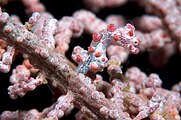
A seahorse is any of 46 species of small marine bony fish in the genus Hippocampus. "Hippocampus" comes from the Ancient Greek hippókampos (ἱππόκαμπος), itself from híppos (ἵππος) meaning "horse" and kámpos (κάμπος) meaning "sea monster" or "sea animal". Having a head and neck suggestive of a horse, seahorses also feature segmented bony armour, an upright posture and a curled prehensile tail. Along with the pipefishes and seadragons they form the family Syngnathidae.

The Syngnathidae is a family of fish which includes seahorses, pipefishes, and seadragons. The name is derived from Ancient Greek: σύν, meaning "together", and γνάθος, meaning "jaw". The fused jaw is one of the traits that the entire family have in common.

Pipefishes or pipe-fishes (Syngnathinae) are a subfamily of small fishes, which, together with the seahorses and seadragons, form the family Syngnathidae.
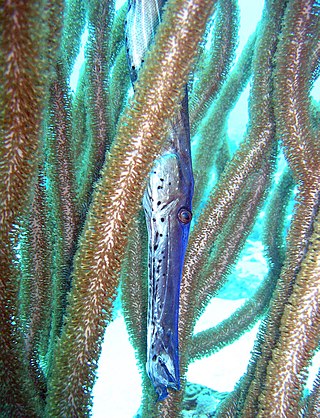
The Syngnathiformes are an order of ray-finned fishes that includes the leafy seadragons, sea moths, trumpetfishes and seahorses, among others.
The pygmy seahorses comprise several species of tiny seahorse in the syngnathid family or Syngnathidae. Family Syngnathidae is part of order Syngnathiformes, which contains fishes with fused jaws that suck food into tubular mouths. They are found in Southeast Asia in the Coral Triangle area. They are some of the smallest seahorse species in the world, typically measuring less than 2 centimetres (0.79 in) in height.

Hippocampus sarmaticus is an extinct species of seahorse, found in 2005 in the coprolitic horizon of the Tunjice hills Lagerstätte in Slovenia, along with the related Hippocampus slovenicus.
The Yucatán pipefish is a demersal fish species native to the Gulf of Mexico.

Acentronura is a genus of pygmy pipehorse native to the Indian and Pacific oceans. The name is derived from the Greek ακεντρονουρα, or a-kentron-oura, and refers to the lack of a sting on the tail.
Amphelikturus dendriticus, the pipehorse, is a species of pygmy pipehorse native to the western Atlantic Ocean. This small, highly camouflaged pipefish is rarely seen. This species grows to a length of 7.5 centimetres (3.0 in) TL. This species is the only known member of its genus.
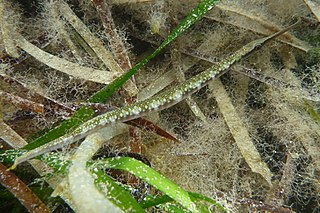
Leptoichthys fistularius, the brush-tailed pipefish, is a species of pipefish of the family Syngnathidae, found in shallow to intermediate depths off the coast of southern Australia, usually in seagrass beds. This species is the largest known species of pipefish, growing to a maximum of 63 cm (25 in) in length. Like other pipefishes, the male carries the fertilized eggs in a pouch under his tail until they hatch. The genus name comes from the Greek leptos meaning "thin" and ichthys meaning "fish", the specific name refers to the resemblance of the head of this species to that of the fluteheads or cornetfishes of the family Fistulariidae.
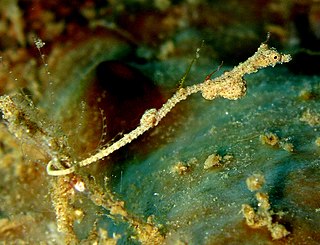
The thread pipefish, also known by its Japanese standard name Hari-youji, is a species of pipefish native to the Pacific Ocean around Indonesia, where it is found at depths from 15 to 20 m. This species grows to a length of 2.68 cm (1.06 in), and is the only known member of its genus.

Syngnathoidea is a superfamily of the pipefish order Syngnathiformes. It is divided into two families, the speciose pipefish Syngnathidae, which includes the sea horses and monotypic Solenostomidae, the ghost pipefishes, which has just five species. The superfamily occurs worldwide in tropical, subtropical and temperate seas, especially in coastal waters around rock and coral reefs and among sea weed and sea grass beds. However, there are also pelagic species of pipefish and even freshwater species. In total the superfamily comprises in excess of 50 genera and nearly 300 species.
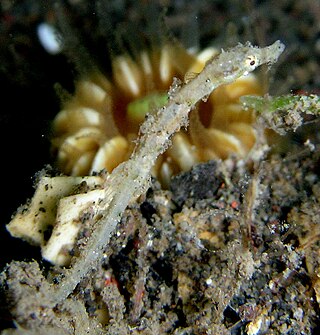
Acentronura breviperula, also known as the shortpouch pygmy pipehorse, dwarf pipehorse and northern little pipehorse, is a species of pygmy pipehorse, a member of the family Syngnathidae, the seahorses and pipefishes. It occurs in the Indo-Pacific region from the eastern Andaman Sea, through the Malay Archipelago to the Western Pacific as far east as New Guinea and the northern Great Barrier Reef.
Lissocampus bannwarthi is a species of marine pipefish belonging to the family Syngnathidae.

Lissocampus caudalis, also called the Australian smooth pipefish or the smooth pipefish, is a species of marine fish belonging to the family Sygnathidae.
Lissocampus fatiloquus, also known as prophet's pipefish is a species of marine fish belonging to the family Syngnathidae. The species has been noted in a variety of habitats including sargassum, seagrass beds and sandy substrates along the coast of Western Australia from Shark Bay to Rottnest Island. Their diet is thought to consist of small crustaceans such as copepods. Reproduction occurs through ovoviviparity in which the males brood eggs before giving live birth.
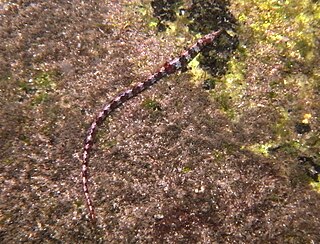
Lissocampus runa, also known as the javelin pipefish is a species of marine fish belonging to the family Syngnathidae. This species can be found in algae beds, rocky reefs, tidepools, and estuaries along the coast of southern Australia from Broken Head Nature Reserve in New South Wales to Rottnest Island, Western Australia. Their diet is thought to consist of small crustaceans such as copepods. Reproduction occurs through ovoviviparity in which the males brood eggs before giving live birth.
Nannocampus pictus, also known as the reef pipefish, is a species of marine fish belonging to the family Syngnathidae. They can be found inhabiting reefs and seagrass beds of the western Indian Ocean and the eastern coast of Australia including the Great Barrier Reef. Members of this species can grow to lengths of 10 cm and their diet likely consists of small crustaceans such as copepods. Reproduction occurs through ovoviviparity in which the males brood eggs before giving live birth.

Hippocampus nalu, the Sodwana pygmy seahorse, African pygmy seahorse or Honeypot seahorse, is a South African species of pygmy seahorse in the family Syngnathidae.
Cylix tupareomanaia, the Manaia pygmy pipehorse, is a species of syngnathid, the family of seahorses and pipefish, and is endemic to New Zealand. It was first described in 2021, and is found in the northern parts of the North Island of New Zealand.



